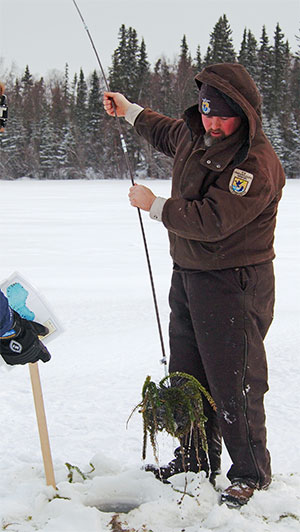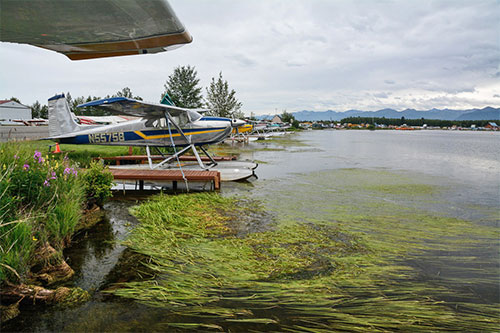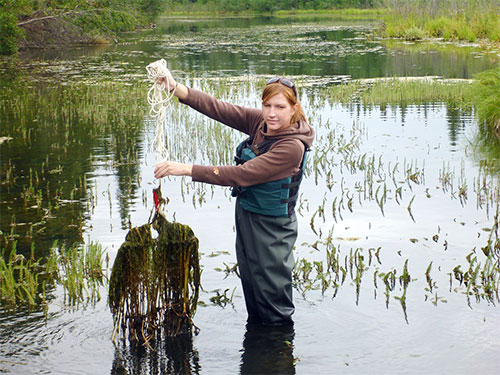
Research will map risk of invasive aquatic weeds in AlaskaBy LAUREN FRISCH
June 27, 2016
Tobias Schwörer, a researcher at the University of Alaska Anchorage Institute of Social and Economic Research, is leading a project to identify where elodea is likely to spread and to evaluate future management options. Schwörer is also pursuing a PhD at the University of Alaska Fairbanks School of Management. Schwörer first considered the effect of elodea on salmon to assess possible economic consequences for Alaska’s salmon fisheries. Now, he is working with floatplane pilots across the state to better map out potential elodea outbreaks and evaluate high-risk locations. This information will be useful to managers and decision-makers looking to determine how to minimize the spread of elodea and evaluate the highest priority spots to eradicate the species. “Toby’s research will help us identify locations where pilots are landing more frequently, and that should translate into an enhanced ability to understand where elodea is going to spread next,” said Joe Little, Schwörer’s adviser and an associate professor of economics at UAF. Elodea was originally introduced into Alaska as an aquarium plant. The weed is rugged and can easily spread and outcompete native plants. Elodea grows in dense mats along lakeshores, in sandy habitats where salmon like to spawn. Spawning can be impaired as the density of elodea increases, because elodea can decrease oxygen supply for fish and crowd out fish habitats. On the other hand, elodea can increase productivity in a waterbody and serve as a nursery for juvenile salmon, which may benefit salmon populations. The weed can also get tangled in floatplane rudders and boat propellers and impair motor function. Case studies from other regions of the United States show that property values may decrease up to 25% near lakes infested with aquatic weeds like elodea. Native plants, on the other hand, typically die or become dormant in the fall when ice cover begins to form. Elodea, however, can photosynthesize under two feet of ice and can persist after being frozen into ice. The plant reproduces asexually when it is torn apart, which can happen from river travel, ice motion, or removal tactics involving chopping and collecting elodea material. When elodea spreads quickly, it can use up a lake’s nutrient supply. Because of this ability to decimate the nutrients in an ecosystem, elodea typically has boom and bust growth behavior that can affect oxygen levels critical for fish.
Floatplanes sit in elodea-infested waters in Lake Hood (Anchorage)
“Toby came to me with this project idea, and has done an exceptional job getting the right people to contribute,” Little said. To consider how elodea could affect salmon, Schwörer pooled together insight from salmon experts with substantial research experience studying salmon ecology and management. He presented a number of habitat scenarios that varied in terms of location of elodea, degree of elodea cover, amount of dissolved oxygen, number of predators and amount of prey. The experts were asked to choose which scenarios were most likely to support a persistent population of salmon for the next 20 years. “This research revealed that most experts believe elodea outbreaks will have a negative impact on growth rate and salmon population sizes,” Schwörer said. He found that on average, the experts anticipated that growth rates for salmon in elodea-infested waters would range from minus five percent to one percent. Growth rates less than one percent represent decreasing population sizes.
Elodea is dense in the Chena Slough in Fairbanks.
So far, the interviews have revealed that many Alaskans are worried about the negative impacts the spread of elodea could have on their business. “Once we have the information from this survey, we can create a map of waterbodies that are at risk to elodea outbreaks because of predicted float plane activity,” Schwörer said. This information can be used to create a strategy to minimize the spread of elodea.” By combining an understanding of where elodea will spread and how it is likely to affect salmon fisheries, resource managers will be able to evaluate possible solutions to regional elodea infestation based on the science as well as projected economic costs. Climate change is projected to increase the number of invasive species that spread to Alaska. The researchers hope this framework for evaluating the risk of elodea could be applied to other invasive species as well. Understanding the most efficient way to determine areas and economies that most at risk for invasive species will become increasingly important. Little explained Alaska is under financial pressure to maintain critical environmental functions at reduced costs. “Funds and resources are limited, so total eradication of an invasive species may not be an option,” he said. “Under limited budget scenarios, it is important to apply the resources we have to the areas that are the most at risk. That’s one major place where the value of this approach is clear.”
This article is provided as a public service by Alaska Sea Grant, a statewide marine research, education, and outreach program, in a partnership between the University of Alaska Fairbanks and the National Atmospheric and Oceanographic Administration. Lauren Frisch [lcfrisch@alaska.edu] is a writer/information officer with Alaska Sea Grant. Representations of fact and opinions in comments posted below are solely those of the individual posters and do not represent the opinions of Sitnews.
|
|||


